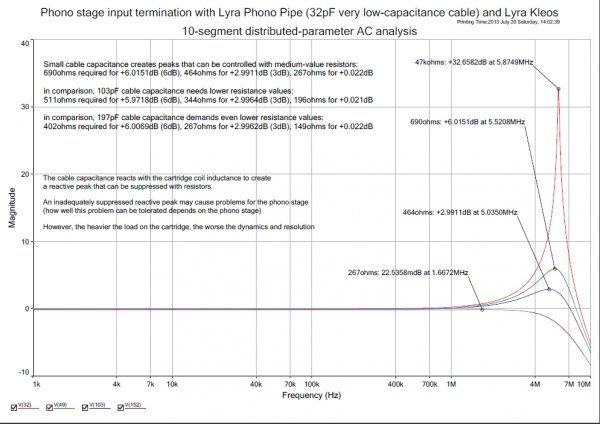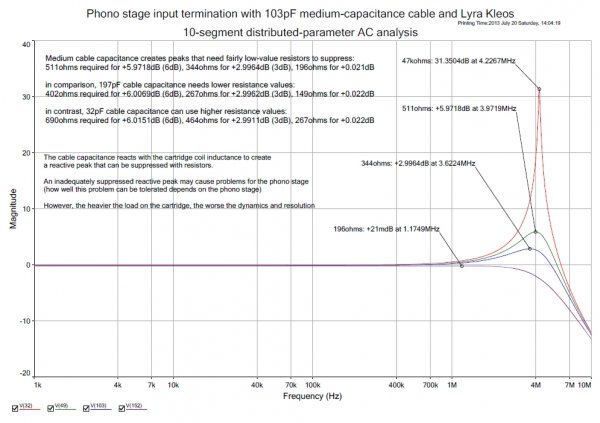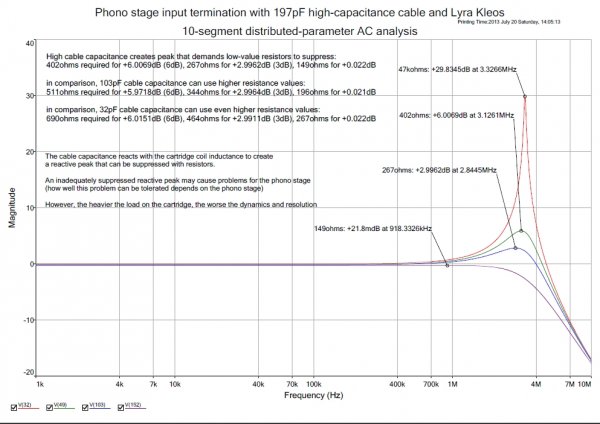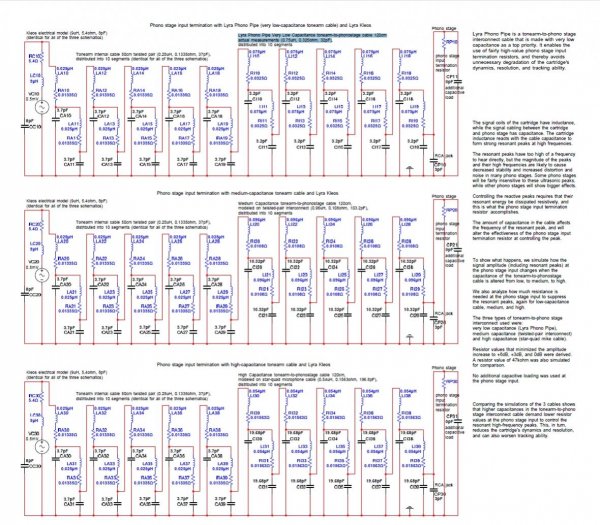Dear @imhififan : We can run several kinds of tests but the real, important and critical issue for any audiophile ( not a fully technical oriented person. ) is if load impedance in a LOMC cartridge changes its frequency response and J.Carr proved it does not and this fact is what we need to know:
- Kleos electrical model (9uH, 5.4ohm, 8pF)
- Lyra Phono Pipe Very Low Capacitance tonearm-to-phonostage cable 120cm actual measurements (0.75uH, 0.325ohm, 32pF)




What these tell me (among other things) is that, all else being equal, changing just the interconnecting cable (each of which has a different capacitance characteristic), changes the optimal resistive load; and if you can afford to bring up that peak in the MHz to something <10dB then you can bring up resistive loading to about 500-1K ohms even with a highly-capacitive cable; and finally, you are not really affecting the audible high frequencies with any resistive load shown. "
He followed:
" To claim that the loading affects the measurable frequency response of the cartridge is bogus. However, if inappropriate loading bathes the phono stage in copius amounts of high-frequency noise, it may start to distort (unless the designer implemented various techniques to make sure that this won’t happen), and the result will likely be intermodulation distortion. IMD products can go low enough to fall within the audible band (even when the stimuli are ultrasonic), and IMD nearly always is not harmonically related to the signal, making it particularly grating to the ear. ""
All those was confirmed in the same old thread by an expert engineering of Analog Devices Co. when he stated with facts:
" certainly not on tracking which is demonstrably false based on IM tests on tracking performance that I have incidentally performed as a function of load. While mechanical impact does occur as a result of electrical load- there is some back emf necessarily generated by the signal current that affects the mechanical motion, but a quick back of the envelope calculation using Lenz’s law and the 10uH cartridge suggests a 2 orders of magnitude difference between the generated signal and the back EMF for a 100 ohm load at 20kHz- certainly not enough to cause tracking issues . By the way, I constructed a model for the cartridge back EMF using Lenz’s law and incorporated it into my simulations.
For those who are interested, the simplest version of the law is V(t)= -LdI/dt.
In this case the parameters can be measured (the LC100A meter from Ebay is a great way to do it) and the back EMF acts to oppose the voltage developed in the coil. The fractional change (attenuation) in the signal voltage is easy to calculate as it approx. equal to -L*2*pi*frequency of interest/Rload. So, it’s inversely proportional to the load R and proportional to the frequency. "
The other issue is if 47k is the standard load for a LOMC cartridge and the evidence showed in " all " active high gain phono stages proved that 47k is not the standard load impedance for LOMC cartridges and along those evidence/facts are the coments of the manufacturers/designers of those phono stages as J.Curl , M.Huber, J.Carr and others. As a fact if exist an standard load for LOMC cartridges this is not 47k but 100 ohms ( some say between 100 ohms-500 ohms. ) but as designers/reviewers/audiophiles know and say the LOMC loading is up to each audio system and owner MUSIC priorities.
Those both issues are already quite clear.
Now, if you want to " see " if load could change cartridge tracking abilities then use the Shure ERA V test record. I understand that you own an active high gain phono stage, this means with no SUT. There are other cartridge tracking test records as Telarc that’s very good. To make this kind of test through a test record you must be sure that the cartridge/tonearm overall alignment/set up is accurated and that the test record and the stylus tip are clean and optimal condition and the run the test and make the load changes you want it.
For me everything is already clear: load impedance does not affects cartridge frequency response and 47k is not the standard for LOMC loading. The test could be only for " fun ". Just do it.
R.

